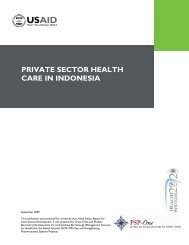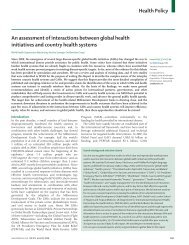southern sudan health system assessment - Health Systems 20/20
southern sudan health system assessment - Health Systems 20/20
southern sudan health system assessment - Health Systems 20/20
You also want an ePaper? Increase the reach of your titles
YUMPU automatically turns print PDFs into web optimized ePapers that Google loves.
county-level data on burden of disease and resource allocation can lead to a redirection of available<br />
resources.<br />
5.5.5 USE OF DATA FOR DECISION-MAKING<br />
Producing data is ineffective if <strong>health</strong> care actors, such as doctors, hospital managers, nurses, financial<br />
administrators, and program managers, do not use the data. The rationale for producing data is to use it<br />
for programming, budgeting, and forecasting, which in turn impact the efficiency of the use of funds and<br />
helps inform decisions, whether they concern the <strong>health</strong> of the patients or the human resource force.<br />
Southern Sudan not only lacks the capacity to produce data, but also to analyze and use data for<br />
decision-making.<br />
5.5.6 MOH POLICIES REGARDING HIS<br />
Recognizing the need for implementing an HIS, the MoH/GoSS plans to (Lomoro <strong>20</strong>07):<br />
• Develop a national M&E framework and implementation guidelines/manual, including development of<br />
a comprehensive national M&E database, and strengthened capacity and institutional infrastructure at<br />
the MoH/GoSS to enhance management of M&E programs in Southern Sudan.<br />
• Establish a functional, effective, and efficient <strong>health</strong> management information <strong>system</strong> including review<br />
and standardization of indicators and reporting formats/tools, and transfer all existing <strong>health</strong><br />
databases to the MoH/GoSS.<br />
• Enhance effective coordination and partnership.<br />
However, it is not clear at present if there will be any links between the M&E and HIS <strong>system</strong>s.<br />
The M&E/<strong>Health</strong> System Directorate has initiated the development of an M&E strategy. A workshop<br />
facilitated by the directorate was held in January <strong>20</strong>07. It engaged the state MoH representatives and all<br />
partner agencies in the process of defining priorities and mechanisms for implementing an M&E <strong>system</strong><br />
framework.<br />
The MoH is in the process of developing an M&E <strong>system</strong> in collaboration with USAID’s Sudan <strong>Health</strong><br />
Transformation Project. The medium-term objectives of this work are to build a national framework for<br />
M&E, conduct a rapid <strong>assessment</strong> of the M&E <strong>system</strong> at the state level, and develop a one-year action<br />
plan for implementation. The M&E <strong>system</strong> will focus on five interventions: reproductive <strong>health</strong>,<br />
HIV/AIDS, IMCI, malaria, and TB. Among other activities is the development of a uniform reporting<br />
format and procedures for routine HIS:<br />
• Data collection tools developed: daily patient register, monthly morbidity summary form, antenatal<br />
care (ANC) register, maternal delivery register, monthly ANC summary register, immunization form<br />
(UNICEF), staffing report, personnel training register, inventory register, water and sanitation form.<br />
• Training manuals developed: trainee manual, trainers’ manual, M&E supervision tools, and baseline<br />
<strong>assessment</strong> tools.<br />
Among the existing plans is the Integrated Disease Surveillance and Response (IDSR) Plan of Action for<br />
Southern Sudan, which is being revised and updated. The IDSR will build on the existing EWARN. IDSR<br />
37
















